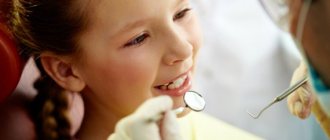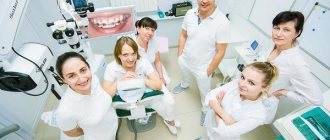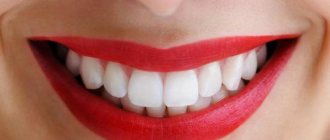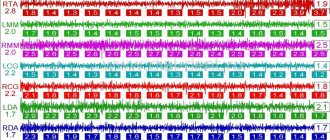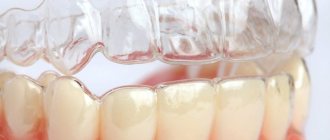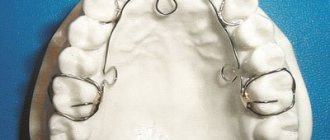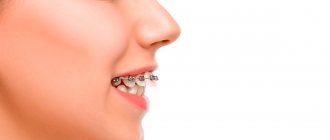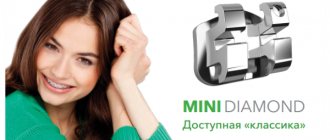Deviations in the development of occlusion, as a rule, are detected in patients of a younger age group - and already during this period it is possible to carry out therapeutic measures aimed at eliminating a specific anomaly. The Andresen-Goipl activator is prescribed in situations where correction of a mixed or permanent bite is required, and is a removable structure that is fixed on the upper and lower rows and forms a single active block that affects the jaw region. The device is created taking into account the individual anatomical features of the structure of the oral cavity, and is allowed for installation starting from the second stage of the formation of the primary occlusion, helping to eliminate cross and mixed occlusion by changing the relative position of the elements.
Design features of the Andresen-Goipl activator
This orthodontic product is a closed monoblock. The activator consists of the following elements:
- plastic base for the upper and lower jaw;
- Coffin springs, manufactured using medical wire 1.2 - 1.5 mm in diameter;
- vestibular arch - made of wire 0.6 - 0.8 mm in diameter;
- a large number of guide planes;
- activating loops, clasps, screw.
The Andresen-Goipl activator is made according to individual patient models obtained on the basis of casts reflecting the expected bite after correction.
Activator manufacturing process
Preparing the system includes several stages. At the preliminary stage, a plaster cast is formed, which is the basis for creating a model of the jaw. Based on the obtained sample, the doctor marks the boundary of the base, and also indicates the placement points of auxiliary structures and the cutting trajectory.
During the manufacturing process, specific factors are taken into account:
- the front border of the apparatus should lie along the cutting surfaces of the top row;
- the posterior border is determined by the line of closure of the lateral units;
- the lower part should cover the sublingual area.
The design is modeled based on the characteristics of the jaw structure. The space between the surfaces is filled with a wax mass, after which bite ridges are installed, combined with the upper model. The finished device is filled with plastic, polished and ground. The bases are sawed in accordance with the originally intended line, after which the functional operation of the system is checked.
Operating principle of the Andresen-Goipl activator
The ability to fix the lower jaw in the required (extended) position gives impetus to its development. In this regard, the growth of the upper jaw is inhibited, the bite becomes disconnected, and the work of the facial and masticatory muscles returns to normal.
Placing an inclined plane along the entire dentition makes it possible to move teeth in three planes - to the side, back and forward. This makes it possible, with some design changes and additions to the activator, to successfully use it to correct not only distal occlusion, but also other deviations of occlusion.
Pathogenesis of open bite
It should be remembered that an open bite can appear in the prenatal period. In this case, the incorrect position of the teeth begins in their rudiments. Therefore, they initially begin to grow crookedly.
Since the rudiments of molars are formed simultaneously with milk teeth, they can also have pathology. This is why in such cases it will not be enough to correct an open bite at an early age. In most cases, therapy will have to be repeated when permanent teeth erupt.
If the bite pathology is caused by external factors, then the formation process is somewhat different. In this case, the position of the dentition is initially correct, but over time it becomes deformed. It is important to notice such distortions in time and begin to correct them. Typically, the latter type of malocclusion is more amenable to treatment compared to congenital pathology.
Indications and contraindications
The use of a monoblock is advisable in correcting the following dental defects:
- Distal bite - to treat this pathology, the guide planes must fit tightly to the mesial surface of the dental crowns in the upper jaw and to the distal surface of the teeth in the lower jaw. The vestibular arch is located on the upper incisors, and the Coffin spring is located in the center of the palatal suture. This position of the activator provokes movement of the lower jaw in the mesial direction. In order to prevent the external (vestibular) inclination of the dental crowns of the lower incisors, when they are in a vertical position, an additional plastic side is made that overlaps the teeth by a third.
- Mesial bite - an activator with an expansion screw and a vestibular arch on the lower jaw is used. This stops the growth of the anterior part of the lower jaw, which helps eliminate the pathology.
- Open bite - when the alveolar process is lengthened in the lateral sections of the dentition, the guide planes are removed in the area of non-occlusion of the teeth - the anterior section. At the same time, they are left in the lateral ones, which leads to “hammering” of the lateral dental crowns and lengthening of the front part of the dentition.
- Deep bite - separation of the bite when filing planes on the side of the premolar and molars leads to the growth and elongation of the alveolar processes of the lateral section. The inclusion of expansion elements in a product involves removing part of the plate to release them.
The Andresen-Goipl activator has a small number of contraindications.
The device cannot be used if the patient has the following pathologies:
- dysfunction of breathing through the nose;
- allergy to materials used in the manufacture of the structure.
Varieties
Since correcting a bite in childhood is not a very difficult task, doctors strongly recommend not delaying a visit to an orthodontist. Until the situation reaches a critical point, a plate can help correct the position of the dentition. Today there are several types of them.
Fixed
Their main purpose is to straighten the teeth from the outside in the shortest possible time. The entire system is a structure consisting of small locks into which strong power arcs made of metal are inserted. It is only necessary to occasionally adjust the tension of the arc, and the result will not be long in coming.
Main advantages:
- Such records are practically invisible to others when communicating.
- Caring for them is very easy and simple, it does not take much time.
- Installing the plates is not painful; anesthesia and anesthesia are not required.
- Efficiency and fairly short term of bite correction.
- Hypoallergenic and safe all materials used.
- Parents do not need to constantly monitor their child’s wearing of the plate, because he cannot remove it.
Like any treatment method, bite correction using plates has several disadvantages:
- They are practically powerless in case of severe deformations and in the presence of individual characteristics of the body.
- Since the system blocks the taste buds, the child may complain of a lack of perception of different tastes.
- Diction may deteriorate and a lisp may appear.
- It takes time to adapt.
Removable
Such orthodontic structures are made strictly according to the individual parameters of the jaw of each individual child. Only a professional doctor can decide which units of the row to attach the fixing elements to.
Removable plates can only help cope with minor bite pathologies and the presence of small gaps.
Positive and negative aspects of the Andresen-Goipl activator
The advantages of this orthodontic product include:
- Treatment with the device takes place at night;
- there are no problems with hygienic care of the product - after use, the orthodontic product is cleaned with a toothbrush and paste, washed under running warm water, dried and stored in a special container;
- there is no need for frequent visits to the dental office;
- the universality of the activator action - eliminates the pathology of occlusion, promotes the correct position of the tongue in the oral cavity and normalizes the functioning of the facial muscles.
The disadvantages inherent in the Andresen-Goipl activator are:
- the need for strict control by parents over the schedule for wearing the product - the result of treatment depends on this;
- the inability to communicate during treatment makes nighttime use of the device preferable.
Advantages and disadvantages
The cost of producing a monoblock and the duration of treatment make parents doubt the proposed solution to the problem. When weighing all the features of the device, one should take into account not only the speed and effectiveness of such correction, but also possible discomfort and complications for the child. The device has a lot of positive qualities:
- The activator can be removed and put on independently, which simplifies the process of brushing teeth and eating. In addition, the child will not feel embarrassed because of a foreign object in the mouth, which prevents him from communicating with peers throughout the day.
- The product is easy to clean, so the child can wash the device independently at a convenient time.
- Simple operating rules.
Despite the fact that the activator has obvious positive characteristics, it should be noted that this type of treatment also has its disadvantages:
- Due to the fact that the device can be removed at any time, the child may not follow the operating instructions. If the product is not worn for the prescribed number of hours, the treatment results may not be noticeable.
- The device must not be used if breathing through the nose is impaired, as it completely blocks the ability to breathe through the mouth. Therefore, before starting the course, you should undergo an examination by an otolaryngologist.
Negative aspects can be avoided if parents take control of the entire process of correcting the bite and monitor compliance with the doctor’s instructions.
Diagnosis of open bite
Often, diagnosing an open bite does not require much time. Usually, the doctor can point out this pathology during the first examination of the patient. To confirm the diagnosis, he can schedule an additional visit to the orthodontist, who can more competently determine the causes of malocclusion and prescribe comprehensive treatment.
If malocclusion was identified at an early age, the doctor may recommend taking an X-ray of the jaw. It is needed to determine the condition of permanent teeth that have not yet appeared on the surface.
Similar orthodontic appliances
The Andresen-Goipl activator refers to closed two-jaw orthodontic devices. However, there are also open monoblocks that do not cover the palate and the front parts of the teeth. Open ones include:
- Janson Bionator. Often used for prognathic distal occlusion. Restrains the growth of the upper row, due to which the bite is corrected.
- The Klammt activator is prescribed to correct the uncharacteristic arrangement of the anterior teeth, as well as for sagittal anomalies. The device has a lighter design compared to other devices. Due to the fact that there is no plastic on the roof of the mouth, the device does not impede speech and can therefore be used throughout the day.
- The Balters bionator is used to correct narrowing of the dentition, protrusion of the anterior teeth and deep bite, open bite and malocclusion of the lower jaw.
Considering that modern dentistry offers a wide range of options for solving the problem of malocclusion in children, parents will be able to give their child a beautiful smile.
What is a bionator and for what purpose is it used in orthodontics
The bionator is a multifunctional corrective system that allows you not only to correct rows and straighten the bite, but also to correct the position of the lower jaw pushed forward or solve the problem of abnormally sized teeth. With its help, you can change the inclination of the crowns, stimulate the muscles of the face and ligaments, and correct the width of the dentition. Experts in the field of orthodontics highlight several important advantages of using bionators, and here are the main ones:
- the design provides for strong fixing and supporting elements,
- the device provides a force sufficient for the systematic and effective movement of curved units,
- the action of the system can be aimed at expanding the jaw arch in order to free up space for the unhindered movement of problem teeth.
Bionator is a multifunctional corrective system.
The device combines the functions of several corrective systems at once. It can be used as a plate, the action of which is aimed at expanding the upper and mobile jaw, and also act as a trainer or retaining device used as part of the treatment of the temporomandibular joint.
Design features
The standard bionator model is a monoblock device with upper and lower plates interconnected. The block includes elements such as a plastic base, wire parts, expansion screw, guide slots and tilt planes.
Such devices come in single- and double-jaw types (monoblock). There are also removable, non-removable and combined models. According to another classification, bionators are therapeutic and prophylactic. The choice of a specific modification is at the discretion of the doctor and directly depends on the individual characteristics of the clinical picture.
Description of the Klammt device
This is a removable bimaxillary device , fixed on the teeth from the incisors to the second molar, leaving the frontal units and palatal vault free, which significantly expands the surface for the tongue and improves the functionality of the dental system.
The device is designed to correct the incorrect position of the anterior elements in several types of abnormal bite.
The device received its name based on the principle of operation, i.e. it is activated during movements of the tongue and jaw , for example, during communication. Bite correction is carried out by moving teeth in a small gap between the hardware arch and the dentition.
The Klammt device is an improved model of the classic Andresen-Goipl device. But unlike its predecessor, it has smaller parameters and a lightweight elastic design, which affects wearing comfort.
This is interesting: Correcting the bite surgically
The device in its design has the following parts:
- two plastic shields adjacent to the alveolar areas of both jaws from molars to canines;
- overlay plates on the side units, covering 2/3 of their surface;
- clasp for the sky in the form of a spring;
- one pair of vestibular arches for the frontal elements of both jaws, which end in horizontal U-shaped bends that prevent biting of the mucous membrane.
Important! According to indications, loops for tongue retraction, spring pushers, labial pads, and half-arches can be added to the device.
Indications
The use of the system is indicated in the following clinical cases, which are various manifestations of defects in the formation of the jaw apparatus:
- distal bite – corrected with the activator of the standard version. In case of a pronounced anomaly, the device can be supplemented with finger-shaped springs, bringing the position of the units back to normal;
- distal blocking bite – the device is made individually based on a dental impression.
The system is equipped with a lip bumper, which slightly reduces muscle tone in the mouth and lips. If the incisors are atypically deployed, the arch intended for the upper row has a slightly different shape and consists of two rounded fragments; - mesial against the background of reverse incisal overlap - the arch in this case is in maximum contact with the lower jaw row, but at the same time practically does not exert any external pressure on the teeth;
- open bite – for its treatment the device is equipped with a tongue shield. Wire arches are localized on the back side of the organs and do not allow the tongue to contact the incisal units;
- protrusion - the structure is installed on the outer side of the jaw at a distance of 0.2 cm from incorrectly positioned teeth so that the arch touches them as tightly as possible;
- cross pathology - involves the use of a standard device, but with a smoother surface, which must be located further away from the side elements of the row.
Contraindications
Absolute contraindications in which the use of the device is not possible:
- allergic manifestations - as the body’s reaction to individual intolerance to the materials included in the device;
- physiological rejection of foreign objects in the oral cavity, bordering on the gag reflex.
In addition, the following relative contraindications may become a temporary limitation to carrying out correction using this method, by eliminating which the ban on treatment with the Klammt device will be lifted:
- exacerbation of serious chronic diseases;
- viral infections;
- inflammatory processes in the oral cavity;
- a number of dental diagnoses that compromise the structural integrity of teeth.
Treatment period
It was noted above that the treatment regimen is determined by the characteristic disorders. When correcting a distal bite, characterized by a narrowing of the jaw row, a vestibular arch is installed on the upper front teeth. The Coffin spring is attached to the middle part of the palatal suture.
For mesial occlusion, wearing an activator with an expansion screw is recommended. The vestibular arch runs along the mandibular anterior teeth. To eliminate violations associated with the location of the upper row of canines, the bends that relate to the specified arch are placed on the medial edges. These elements are then tightened to create additional tension.
The duration of treatment with the activator depends on the individual characteristics of the patient. On average, restoration of the bite takes about 1.5 years. In some cases, treatment is completed several months after installation of the device.
The design makes communication difficult, which is why it is usually used at night.
This is interesting: At what age can the T4K Trainer be used - its purpose and price
The use of the design is extremely contraindicated for patients who have problems with nasal breathing.
Single jaw plates
They consist of a plate base with one or more orthodontic screws. This is a mechanical device, removable. It is used in primary, mixed and permanent dentition with uniformly and unevenly narrowed dentition, shortened dentition, and abnormal position of individual teeth. The principle of operation is to use the pressure that occurs when unwinding or tightening the screw spindle to uniformly or unevenly expand the dentition, move individual teeth and groups of teeth.
Treatment prices
The cost of correcting an open bite directly depends on the complexity of the defect. The total cost includes inspection and consultation with a specialist, payment for the procedure for installing a correction device, as well as the purchase of the structure itself. If surgical intervention is required for bite therapy, the price will be higher.
It is better to find out more about how much such bite treatment will cost directly in the clinic.
The iOrtho clinic network provides high-quality services for correcting malocclusion with Invisalign aligners, sign up for a consultation now!
General introduction and purpose of application
Bionators are myofunctional devices with combined effects. The purpose of their use in orthodontics is to eliminate functional or morphological disorders of the dental system during periods of primary or permanent dentition.
The devices can rearrange the position and inclination of the teeth, expand/contract the jaws and rows of teeth, and eliminate the incorrect relationship of the jaws relative to each other. Bionators work well with facial muscles and jaw ligaments.
Successful correction of malocclusions using devices is ensured by:
- reliable fastening and stable support;
- sufficient strength to move and turn teeth;
- the absence of an obstacle in the way of displaced units, and the availability of space in a row.
Classification and stages of development of open bite
Open bite is distinguished depending on its location. In this case, front and side options are distinguished. There are also types of open bite based on jaw location. These are combined options that affect both jaws, as well as the maxillary and mandibular.
Traditionally in dentistry, there are three stages of development of such a defect as an open bite, which differ in the degree of its severity:
- At the first stage, the gap between the teeth does not exceed 5 mm.
- At the second stage, it can range from 5 to 9 mm.
- The third stage is characterized by a gap larger than 9 mm.
Depending on the stage of the disease, the doctor will select the most effective treatment method.
Advantages of contacting the First Family Clinic
- Preparation of an individual bite correction program for each patient.
- Selecting a model of removable braces that suits the situation.
- Treatment is supervised by highly qualified experienced specialists.
- Carrying out computer diagnostics of the condition of the dentofacial apparatus for the most accurate assessment of the clinical case and selection of optimal treatment tactics.
- Regular promotions and discounts that make prices for our services even more affordable.
Our orthodontists are seen in the Primorsky district at 36/2 Kolomyazhsky Ave. (metro stations “Pionerskaya”, “Udelnaya”) and st. Gakkelevskaya, 20, building 1 (metro station "Staraya Derevnya", "Komendantsky Prospekt"), and in the Petrogradsky district - Kamennoostrovskaya Ave. 16 (metro station "Petrogradskaya", "Gorkovskaya", " Chkalovskaya").
